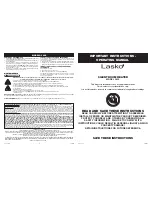
28
GB
The ventilation holes on the container sleeve of the canister must not be covered. It is
possible that gas could leak out and collect in the holder which creates a risk of explosion.
Never move the device when it is switched on (risk of burning).
When the device is turned on, the gas canister should always be placed in the designated
container sleeve.
In order to prevent injury from sharp edges we recommend wearing safety gloves during as-
sembly.
Only use the gas types and canisters recommended by the manufacturer!
Repairs and maintenance of gas-related parts are only to be carried out by authorised
specialists.
In case of malfunction, the regulator valve should be closed.
The gas hose should be inspected for damage at least once a month and each time the canister
is changed.
The
gas
hose
and
pressure
regulator
should
be
inspected
every
fi e
years
by
an
authorised
specialist. After 10 years you have to replace the gas hose and pressure regulator by an
authorised specialist!
If the gas hose is damaged, it must be replaced by a hose of the same quality and length.
In the event of a gas leakage, the device should not be used. If it is in use, the gas supply must
be blocked. Before it is used again, the device must be thoroughly checked and any damaged
parts replaced. Any loose connections must be tightened.
3.
CONNECTING THE DEVICE TO THE GAS CANISTER
THE FOLLOWING PARTS ARE NECESSARY TO CONNECT THE APPLIANCE TO THE GAS BOTTLE:
commercial propane/butane gas – liquid gas canister
fi ed-value
approved
pressure
regulator,
1.5
kg/h,
suitable
for
the
gas
canister,
operating
pressure 30 mbar
approved 0.4 m hose
approved leakage locating spray or foaming agent (e.g. Gas Control Spray or suds).
A
Union nut
B
Regulator valve
C
Canister valve
D
Hose (EN 16436, Ø 8 mm)
E
Gas supply
Y
Gripper clamp
Z
Gas pressure regulator (EN 16129)
A
E
D
Z
C
B
Illustration 2.
Y
Gas bottle: max. 59 cm x Ø 30 cm
















































